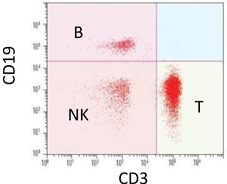Flow cytometry
Cytometry means the analysis of certain properties of cells, like the number of cells, their size, the presence of certain cell surface proteins on them or inside the cell and so on. This technique is called flow cytometry because it lets cells flow through a very small tube and uses this to analyse their properties.
Flow cytometry can be used to measure a lot of things:
- Determining immunophenotype of cells (determine the type of cancer)
- Measure how many cells in a population express a specific antigen or protein
- Determine DNA and RNA content in the cells
- Evaluate the functions of cells, like the phagocytosis, chemotaxis or the intracellular [Ca2+]
- Measure levels of cytokines
- It can also sort cells
Let’s say we’d like to analyse the size of a bunch of cells in a Petri dish. We put these cells into a flow cytometer, which will direct the cells into a perfect, straight line of cells. The cells will then pass through a thin capillary, and a special laser is pointing straight at the capillary, so that the laser will pass through every single cell. The scattering of the laser when it hits a cell can be analysed by a computer that draws conclusions on the cell’s size.
To analyse what surface proteins are found on certain cells the cells must be labelled with antibodies labelled with fluorochromes, like in fluorescent microscopy. When cells labelled with these antibodies pass the laser can the machine differentiate cells based on their color.
Dot plots
Flow cytometry produces a type of plots called dot plots, that we can analyse. Here are two examples.


Dot plots are always displayed as many dots on a graph with 2 axes. The X and Y axes are different depending on what we want to analyse. In the figure to the left, we can look at the number of T-cells in the sample compared to B and NK-cells. CD3 is marked on the X axis, and CD19 on the Y axis. The further you go along one axis, the more of the surface protein marked by that axis can be found on the cells. In the lower right quadrant (marked with NK) there will be one dot for each cell that has no CD3, and no CD19. The cell type that has neither CD19 nor CD3 are the NK cells. In the upper left quadrant are the cells that have CD19 but don’t have CD3, which are the B-cells. In the lower right quadrant are the cells that have CD3 but don’t have CD19, which are the T-cells. There are (basically) no dots (and therefore no cells) in the upper right quadrant because there exists no cell type that has both CD19 and CD3. The figure below shows a different but similar dot plot.
On this plot, the Y axis marks the presence of CD25 which is a surface protein only found on activated T-cells. On the X axis is CD3 which is only found on T-cells. The upper right quadrant shows the cells that have both CD3 and CD25, which are the activated T-cells. By using a computer to count the number of dots, we can determine how many of the T-cells present were activated, which can indicate infection.

